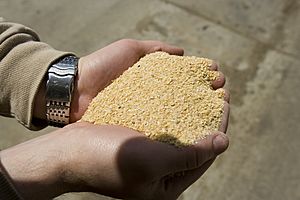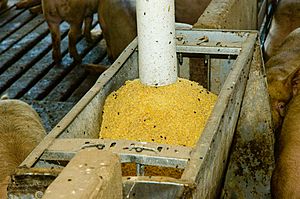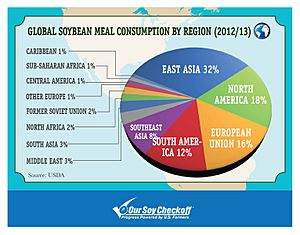Soybean meal facts for kids
Soybean meal is a product made from soybeans. It's mostly used in animal feeds, like for chickens and pigs, because it's a great source of protein. It also gives animals energy. When you process one bushel (about 27.2 kilograms) of soybeans, you get about 21.8 kilograms of soybean meal.
Sometimes, soybean meal is made after soybean oil has been taken out of the beans. Also, some types of soybean meal include the outer shells (hulls) of the soybeans, while others don't. During its production, soybean meal is heated. This heating process helps to break down certain substances in soybeans called trypsin inhibitors. If these inhibitors weren't broken down, they would make it harder for animals to digest the protein in the meal.
Contents
Different Kinds of Soybean Meal
There are three main types of soybean meal, each with slightly different uses:
Full-Fat Soybean Meal
- This type is made from whole soybeans, meaning it still has all its natural fats.
- It gives animals a lot of energy.
- It has about 38 percent protein.
- Farmers sometimes feed this to different kinds of farm animals.
Defatted Soybean Meal (No Hulls)
- This meal has had most of its fat removed, and it doesn't contain the soybean hulls.
- It has a good amount of energy, but less than the full-fat kind.
- It's very high in protein, usually around 48 percent.
- This type is often fed to animals like pigs and chickens.
Defatted Soybean Meal (With Hulls)
- This type also has most of its fat removed, but it still includes the soybean hulls.
- The hulls are easy for animals like cows and sheep (called ruminants) to digest.
- It's often used to give extra protein to these ruminant animals.
- It has about 44 percent protein.
How Soybean Meal is Used in Animal Feed
Around the world, about 98 percent of all soybean meal is used to feed animals. In the United States, for example, a lot of the soybeans grown are processed into meal. About 35 percent of all US-produced soybeans end up as soybean meal for animals in the country. Most of the rest is sent to other countries.
Here's how soybean meal is used in animal feed in the US:
- Almost half (48 percent) goes to poultry (like chickens and turkeys).
- About a quarter (26 percent) is fed to pigs.
- Beef cattle get about 12 percent.
- Dairy cattle (cows that produce milk) get about 9 percent.
- A small amount (3 percent) is used in fish feed.
- Even less (about 2 percent) is found in pet food.
Even though the amounts for fish and pets seem small, soybean meal is still very important for their diets. For example, young lambs that are growing fast and not getting enough protein from their regular food can get a big boost from soybean meal. It's also tasty for them, so it's often used in special starter foods for lambs.
Uses as Human Food
Only about 2 percent of soybean meal globally is used for human food. It's often turned into soy flour and other products. Soy flour can be used to make some types of soy milk and products like textured vegetable protein (TVP), which is often used as a meat substitute. Soy flour comes in different types, like full-fat, low-fat, or defatted, depending on how it's processed.
Phytoestrogens in Soybean Meal
Soybeans contain natural plant compounds called phytoestrogens. The main types found in soy are called genistein and daidzein. Scientists have studied different soy products, including soybean meal, to see how much of these compounds they contain. The amounts can vary, but they are always present.
For example, in some tests, defatted soy meal had certain amounts of genistein and daidzein. Even whole soybean meal contains these compounds. While some studies have looked at how these compounds might affect animals, adding soybean meal to the diet of sheep, for instance, has not shown any harmful effects on their ability to have babies.




